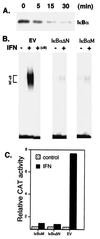IFNalpha/beta promotes cell survival by activating NF-kappa B
- PMID: 11095741
- PMCID: PMC17627
- DOI: 10.1073/pnas.250477397
IFNalpha/beta promotes cell survival by activating NF-kappa B
Abstract
IFNs play critical roles in host defense by modulating the expression of various genes via signal transducer and activator of transcription factors. We show that IFNalpha/beta activates another important transcription factor, NF-kappaB. DNA-binding activity of NF-kappaB was induced by multiple type 1 IFNs and was promoted by IFN in a diverse group of human, monkey, rat, and murine cells. Human IFN promoted NF-kappaB activation in murine cells that express the human IFNalpha/beta receptor-1 signal-transducing chain of the type 1 IFN receptor. IFN promotes inhibitor of kappa B alpha (IkappaBalpha) serine phosphorylation and degradation, and stimulates NF-kappaB DNA-binding and transcriptional activity. Importantly, IFN promotes cell survival by protecting cells against a variety of proapoptotic stimuli, such as virus infection and antibody-mediated crosslinking. Expression of superrepressor forms of IkappaBalpha, besides inhibiting IFN-mediated NF-kappaB activation and IkappaBalpha degradation, also enhanced apoptotic cell death in IFN-treated cells. We conclude that NF-kappaB activation by IFNalpha/beta is integrated into a signaling pathway through the IFNalpha/beta receptor-1 chain of the type 1 IFN receptor that promotes cell survival in apposition to various apoptotic stimuli.
Figures





References
-
- Branca A A, Faltynek C R, D'Alessandro S B, Baglioni C. J Biol Chem. 1982;257:13291–13296. - PubMed
-
- Uze G, Lutfalla G, Gresser I. Cell. 1990;60:225–234. - PubMed
-
- Novick D, Cohen B, Rubinstein M. Cell. 1994;77:391–400. - PubMed
-
- Domanski P, Witte M, Kellum M, Rubinstein M, Hackett R, Pitha P, Colamonici O R. J Biol Chem. 1995;270:21606–21611. - PubMed
-
- Friedman R L, Stark G R. Nature (London) 1985;314:637–639. - PubMed
Publication types
MeSH terms
Substances
Grants and funding
LinkOut - more resources
Full Text Sources
Other Literature Sources

